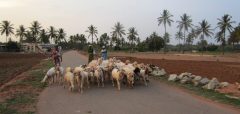
Bullocks have always been an integral part of Indian agriculture. They are important as source of power (-for farm operations and transport) and manure. The symbiotic relationship between bullocks, agriculture and the agriculturist has been very unique and distinct. They (bullocks) are much more than a source of power and manure. They were loved and even worshiped. In a typical farm household in North Karnataka, bullocks are tied in the front portion of the house while the family stays in the adjoining portion. Bullock pairs used to be given names (much like children) as Rama-Laxmana, Lava-Kusha, Basava-Allama, Raja-Raya, Hara-Nandi, after heroic characters from history and mythology. When a bullock dies or succumbs to some injury, family members experienced pain and agony.


With the dawn of modern agriculture, mechanization was introduced to increase efficiency and reduce labour requirement. Farmers were given loans and subsidies to purchase various agricultural machines including tractors. In the late 1970s, there came a World Bank aided tractor scheme, where in farmers were given loans to purchase tractors at an interest rate of 9.5%.
Branches of nationalized banks in North Karnataka were given targets to finance tractors. National Bank for Agriculture and Rural Development (NABARD from 1982; till then Agricultural Refinance and Development Corporation) laid down certain eligibility norms for farmers to avail loans. It was considered that the existing animal power will be replaced by tractors. It was also defined that a tractor should have 1000 work hours per year (including work on the applicant’s farm, co-applicant’s farm as well as other work like transportation on hire). Those were technical calculations to verify if the project can be economically viable and if farmers can repay the loan with interest in addition to saving something for maintaining the machine. Benefit-Cost Ratio (BC Ratio) and Internal Rate of Return (IRR) proved that the scheme is highly viable.
Bank branches especially in the northern districts of Karnataka went in for tractor financing in a big way through endless propaganda. The whole area started roaring with the noise of tractors – Ford, Eicher, Mahindra, Kirloskar and Massey Ferguson were common sight. There was great amusement amongst the rural communities. Driving a tractor was fun for the rural youth. Loud speakers were fitted to the tractors and their noise filled the air, announcing prosperity and joy.


The amusement and fun did not last long. First year with great difficulty tractor owners managed to pay loan installments. From the second year onward, it was very clear that tractors were not bringing the expected returns. BC ratios, IRR and other calculations had hidden something. There were more number of tractors than what the area demanded! Each tractor could not log in the required number of hours for the credit financials to work out.
On displacing animals by tractors that the bankers had calculated, the story was different. When asked by the loan recovery officers as to why their bullocks are still being maintained, reply was straight forward – “Who told you that we will sell our bullocks? How can you think of such proposals? If you want, please take your tractor away. Do not advise us to part with our animals, they are not machines, they are an integral part of our life”
How do you measure this bondage? Pairs of Hallikars, Amrith Mahals or even non-descript bullocks are rather valuable for small family enterprises built on agro-ecological resilience. Can technology and financial viability be so unimaginative that they can’t find opportunities in such cultural-ecological linkages?


(krishna.kothai@azimpremjifoundation.org)
